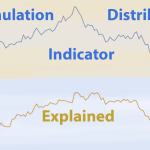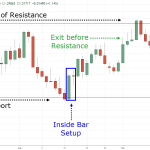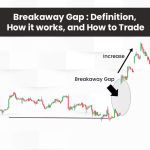
By ATGL
Updated January 29, 2025
The head and shoulders pattern stands as one of technical analysis’s most recognized and significant chart formations. This price action pattern signals a potential trend reversal, marking a transition from bullish to bearish market conditions when it appears in an uptrend. For traders focused on stock forecasting, understanding this pattern provides valuable insights into possible market direction changes.
What Is a Head and Shoulders Chart Pattern?
A head and shoulders pattern forms when price action creates three peaks, with the middle peak (head) rising higher than the two surrounding peaks (shoulders). The pattern takes shape through a sequence of price movements: an upward trend to the left shoulder, a pullback, a higher peak forming the head, another pullback, and finally, a lower peak creating the right shoulder. A line connecting the lows between these peaks forms the neckline, which serves as a critical reference point for trading decisions.
This formation typically indicates a bearish reversal, suggesting that an upward trend may be losing momentum and preparing to shift direction. The pattern’s completion occurs when the price breaks below the neckline, often leading to a significant downward movement.
What Is the Inverse Head and Shoulders Pattern?
The inverse head and shoulders chart pattern mirrors the traditional formation but appears at market bottoms. As a bullish pattern, it signals a potential reversal from bearish to bullish conditions. This variation shows three troughs instead of peaks, with the middle trough (head) dipping lower than the two surrounding troughs (shoulders). The pattern completes when the price breaks above the neckline, potentially initiating an upward trend.
Head and Shoulders Pattern Rules to Identify It
Understanding the key components helps traders accurately identify this pattern and distinguish it from similar formations.
Three Peaks
The pattern requires three distinct peaks, with the middle peak notably higher than the others. The left and right shoulders should reach approximately similar height levels, though perfect symmetry rarely occurs in real market conditions. These peaks should develop over a sufficient time frame to represent genuine market momentum shifts rather than short-term price fluctuations.
Declining Peaks
After forming the head, subsequent price action should demonstrate declining momentum. The right shoulder must peak at a lower level than the head, indicating diminishing buying pressure. This declining peak structure provides evidence of weakening bullish sentiment and strengthening bearish forces in the market.
Neckline
The neckline connects the lows between the peaks, serving as a support level. While textbook patterns show a horizontal neckline, in practice, this line often appears slightly ascending or descending. The angle of the neckline can influence the pattern’s reliability and potential price targets after breakdown.
Volume Confirmation
Volume patterns typically show higher trading activity during the formation of the left shoulder and head, with declining volume during the right shoulder’s development. This volume signature helps confirm the pattern’s validity, as decreasing volume during the right shoulder formation suggests waning buying interest.
Head and Shoulders Pattern Trading: 5 Tips
Successfully trading this pattern requires careful attention to entry timing, position sizing, and risk management.
- Wait for neckline breakdown confirmation before entering trades: A decisive break below the neckline, accompanied by increased volume, provides stronger confirmation of the pattern’s completion.
- Calculate price targets using the pattern’s height: Measure the vertical distance from the head to the neckline, then project this distance downward from the neckline break point to establish a potential price objective.
- Monitor volume during pattern formation and breakdown: Strong volume during the breakdown confirms the pattern’s validity and increases the probability of a successful trade.
- Consider multiple time frames when analyzing the pattern: Patterns appearing on larger time frames often provide more reliable signals than those on shorter time frames.
- Use additional technical indicators for confirmation: Momentum indicators, moving averages, and other technical tools can help validate the pattern’s signals.
Head and Shoulders Chart Pattern Pitfalls to Avoid
Premature Entry
Many traders enter positions before pattern completion, risking false breakouts. Wait for clear neckline breakdown confirmation before initiating trades. This patience helps avoid losses from failed patterns or premature signals.
Ignoring Stop-Losses
Failing to implement proper stop-loss orders exposes traders to excessive risk. Place stops above the right shoulder for short positions, allowing enough room for normal price fluctuations while limiting potential losses.
Trading Unreliable Patterns
Not all head and shoulders formations lead to successful trades. Avoid trading patterns that lack proper proportions, show irregular volume patterns, or form during choppy market conditions.
Master the Head and Shoulders Pattern with Above the Green Line
Transform your trading approach by mastering technical analysis patterns with Above the Green Line’s comprehensive trading resources. Our membership provides access to expert analysis, real-time pattern identification tools, and educational resources that help you spot and trade these patterns effectively. Visit our membership page to elevate your trading strategy.
FAQs About the Head and Shoulders Pattern
Is head and shoulders a bullish pattern?
The traditional head and shoulders pattern indicates bearish sentiment and potential downward price movement. However, its inverse variation (inverse head and shoulders) represents a bullish signal, suggesting possible upward price movement.
What is the rule of head and shoulder pattern?
The primary rule requires three peaks with the middle peak (head) higher than the two surrounding peaks (shoulders), connected by a neckline through their lows. Valid patterns should demonstrate appropriate volume characteristics and a clear neckline break for confirmation.
What usually happens after a head and shoulders pattern?
Following a confirmed head and shoulders chart pattern completion (neckline break), prices typically decline by a distance at least equal to the pattern’s height. However, market conditions and other factors can influence the extent of the subsequent price movement.
How reliable is the head and shoulders pattern?
When properly formed and confirmed, the head and shoulders pattern demonstrates approximately 75% reliability in predicting price reversals. Success rates increase when the pattern appears on higher time frames and receives confirmation from multiple technical indicators.






